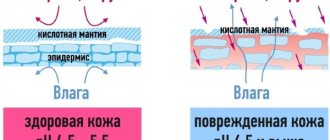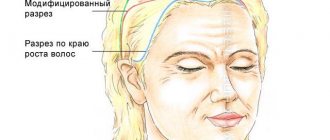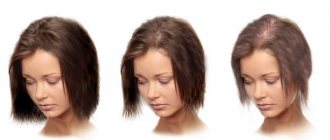Superciliary ridges and frontal ridges
The front part of the skull consists of the maxillary and zygomatic bones, which are formed in pairs. A single lower jaw bone is present. Most of the face is occupied by the frontal bone, above which there are the frontal tubercles, and below them there are the brow ridges. Along the edges of the arches, the bone ends with the eye sockets and the bridge of the nose.
Men have more pronounced brow ridges and frontal bumps. Women have softer and calmer facial features. The difference is due to the fact that the sexual development of boys and the period of active growth occurs later. During this period, the production of the male hormone testosterone increases in men, which contributes to an increase in the development of a pronounced brow ridge.
Difference between a male and female face
The skeletal structure of men and women is different. Male bones are generally wider than female bones. A similar comparison can be made for the bones of the skull. The male skull has more pronounced temporal arches, cheekbones and jaw bones.
The main difference between both sexes is noticeable in the upper part of the face. The female forehead is less developed, the brow ridges are less pronounced. Women's eyebrows are set high, raised above the eyes and curved.
When drawing a line from the edge of the hair to the area of the brow ridges, it becomes noticeable that a woman’s forehead is more sloping than a man’s. The distance from the hair on the head to the eyebrows is greater in men than in women. When looking at photos of the brow ridges, it becomes clear that the eyebrows of men hang over their eyes, making the forehead appear massive.
Hairline
The hairline can also tell a lot about a person's mental abilities, wisdom and personality.
1. Straight hairline
A straight hairline represents the logical mind. Such a person approaches any issue from a practical point of view and believes that problems can only be solved rationally.
They often succeed in business, successfully build a career and achieve success and prosperity. However, their senses are very poorly developed, they lack imagination and creative abilities.
Sometimes a straight hairline can be short and indicates a person's irritable and hot-tempered nature. He has an intractable character and rarely changes his views. Such people often have an unhappy childhood, which is why they crave love and warmth throughout their lives. However, love relationships bring them a lot of grief.
2. Rounded hairline
A rounded hairline often belongs to kind, responsible and loyal people who love to help others. Such people also often receive help and protection from others, enjoying a long and happy life, a good social position and a certain amount of prosperity.
Men with a rounded hairline have a good disposition, but can be weak. Women with this type of hair growth may find it difficult to get married due to their independent nature.
3. M-shaped hairline
An M-shaped hairline belongs to versatile, successful people who can handle hardships easily and can build a career out of nothing. They are talented and smart in small things, quick-witted in their youth, can devote themselves to art and literature, and have a unique perspective in specialized fields.
Moreover, the wider the arcs on both sides of the hairline, the greater luck and creativity this promises its owner. If the arcs are narrow, then the person rather wants to seem talented without having sufficient abilities.
4. Uneven or zigzag hairline
A W-shaped hairline belongs to obstinate and unyielding people. In their youth they may be haunted by failures.
However, if the forehead is high and wide, this promises them success in their chosen field. Women with uneven hairlines often have unsuccessful marriages and are advised to look for a husband 10 years older or younger than themselves.
5. Widow's Mountain
If the hair grows in a triangular protrusion on the forehead, then such a person is considered to be hot-tempered, persistent, with a developed spirit of competition, inquisitive, courageous and decisive.
He has to achieve everything in life through his own labor in order to gain some kind of wealth. In men, "widow's mountain" can indicate the absence of a father and early adulthood. For women, this can also indicate the loss of a father, as well as marriage to a much older man.
Symbol of aggression
Western scientists have come to the conclusion that the external structure of the skull can be used to determine a person’s character and behavioral characteristics. When studying the issue, special attention was paid to the dependence of the forehead and brow ridges on the amount of testosterone in men.
Studies of the skull of an ancient man, a descendant of Pithecanthropus, led to the conclusion that the shape of the skeleton and skull changed as a result of evolution. The changes lasted several millennia and contributed to the development of communication skills in ancient man.
The striking features of the man’s ancestors are a square jaw and large brow ridges. These traits have been passed on to the modern man in a milder form. A person with a pronounced chin and eyebrows seems more masculine and strong.
Scientists have concluded that the main reason the skull evolved this way was to demonstrate aggression and leadership among its kind. The one who seemed scarier and more gloomy turned out to be stronger.
An analogy can be drawn with male mandrill monkeys. Dominant males have brightly colored bulges on their heads. It is worth noting that these monkeys have high testosterone levels compared to other monkeys. This indirectly indicates that pronounced brow ridges appear due to high levels of male hormone in the body. Such a man has leadership qualities and masculinity.
Why did our primitive ancestors “wear” brow ridges?
Many hypotheses about the function of the brow ridges in ancient people have been put forward. For example, there was an opinion that they served as a “visor” from the sun or protected the eyes from sweat and hair, but no convincing evidence for this was ever found. Recently, the so-called mechanical theory
, according to which the brow ridges increased the resistance of the skull bones to chewing loads, and
spatial
, which emphasizes their role in the formation of bone joints in the orbital area.
To clarify the truth or falsity of these hypotheses, British scientists used a 3D computer model of the skull of Heidelberg
Man
, who lived 600–200 thousand years ago. The prototype was a skull found by archaeologists in the Kabwe cave (Zambia). By modeling the load on the masticatory system, scientists found that the brow ridges do not participate in this process in any way; as for the orbit, in this case their size does not matter. It was necessary to look further.
Scientists turned to studying animals that had morphologically similar formations. So, the male mandrill
, a very picturesque monkey from the ape family, there are conspicuous swellings on the sides of the nose, and the bones that form their basis have a structure characteristic of the fossil bones of the brow ridges of human ancestors. The growth of these formations in monkeys is regulated by male sex hormones, and the size reflects the social status of the animal: dominant monkeys boast the largest.
Thus, pronounced brow ridges in our early ancestors could play the role of a morphological marker of leadership qualities and aggressive behavior of an individual. Over the past 100 thousand years, the brow ridges have become smaller, which was probably at first a side effect of the reduction of the facial skull as a whole. In the last 20 thousand years, when people moved from the “mobile” lifestyle of hunters and gatherers to a sedentary agricultural one, this process accelerated significantly. And pay attention: an important result of the reduction of the bones of the superciliary arches was increased mobility of the eyebrows.
Eyebrow movements are one of the tools of social interaction with which we express a huge range of emotions and their nuances. For example, a quick “rise” of eyebrows is a universal signal of openness and readiness to communicate; a slow rise is a sign of surprise or indignation. From small movements of the eyebrows, information can be extracted indicating the degree of truthfulness of a person. On the other hand, according to research results, some people after cosmetic injections of the neurotoxin Botox
, which limits muscle contractions and, accordingly, eyebrow movements, the ability to experience emotions also decreases.
Modern humans are the only surviving member of the subfamily Homininae, which also includes Neanderthals.
and
Pithecatropa
. The rest of its members disappeared: they partially died out, and partially mixed with people of the modern physical type, who settled throughout the globe, often surviving in quite extreme conditions. The ability for social interactions and mutual assistance contributed greatly to our prosperity. And, according to scientists, movable eyebrows could play an important role in the preservation of modern humans as a species, serving as a tool for emotional communication.
Photo: https://www.flickr.com
Prepared by Maria Perepechaeva
Eyebrows and testosterone
American anthropologist and researcher Helen Fisher believes that the brow ridges and some other facial features of men grow under the influence of testosterone. Thanks to this, you can find out how courageous a man is. According to his method, a man with a massive jaw is a strong and powerful person, ready to fight under any life circumstances. Such a person is a leader who is accustomed to subjugate others.
Women evaluate the appearance of men, paying attention primarily to the face. The overall impression has an impact on the opposite sex, but the face will give more social information. By appearance one can assess physical strength, before which fear or admiration may arise. A person with large facial features looks more threatening. A woman, evaluating a man, intuitively decides whether he can become a protector of her and her offspring. A person with pronounced brow ridges seems more experienced and strong in confrontation with other people.
Thus, testosterone is the main cause of masculinity, brutality and the culprit of large facial features.
Reducing brow ridges helped people find common ground
Models of modern human and Heidelbergian human skulls.
Paul O'Higgins, University of York
The prominent, massive brow ridges characteristic of early humans have shrunk over time, and the eyebrows have become more flexible to facilitate communication, according to archaeologists from the University of York. Scientists have created a digital 3D reconstruction of the skull of Heidelberg Man - Homo heidelbergensis
— and analyzed the different sizes of brow ridges in ancient people.
Movable eyebrows allow modern people to demonstrate a wider range of emotions, scientists write in an article published in Nature Ecology&Evolution
.
One of the noticeable anatomical features that distinguishes modern people from distant ancestors is the reduced brow ridges. Anthropologists have several theories to explain the massive brow ridges. Some scientists believe that large brow ridges originally formed to reduce the stress on the skull bones during biting and chewing rough food. According to another hypothesis, large brow ridges smoothed the connection of the skull bones that form the eye socket. Another suggestion is that the flattening of massive brow ridges in anatomically modern humans resulted from “self-domestication”—the development of morphological, physiological, and behavioral traits that emerged through the selection process for non-aggressive, tolerant, and social humans.
Archaeologists from the University of York, led by Paul O'Higgins, decided to test all three hypotheses. To do this, they examined the morphology of the Heidelberg Man skull, which was found in the Kabwe mine, in Zambia. Scientists dated the remains to a period of 300-125 thousand years ago. Heidelberg man, Homo heidelbergensis,
is considered the closest predecessor of modern humans.
The authors of a new study based on computed tomography of the skull created a three-dimensional digital reconstruction of it. In one version, the skull was recreated with the "natural" brow ridges that the person actually had. In two other versions, scientists virtually increased or decreased the brow ridges. They hypothesized that if brow ridges actually influence the stress on the skull bones, then larger brow ridges would minimize it. The researchers then simulated bites of different strengths, measured the load that falls on different teeth and calculated how much stress the brow ridges experienced.
It turned out that during a bite, the tension that was transmitted to the brow ridges was small and did not depend on their size. It also turned out that massive brow ridges were not needed in order to smooth the connection of the bones of the orbit. Therefore, the authors of the article rejected hypotheses linking the appearance of large brow ridges with mechanical and spatial causes and suggested that the brow ridges were one of the signs of sexual dimorphism and decreased as a result of socialization and a decrease in the aggressiveness of people.
For an analogy, researchers cite other primates. “By observing other animals, interesting assumptions can be made regarding the role of prominent brow ridges. Dominant male mandrills have bright blue bumps on either side of their nose that show their status, and their growth is influenced by hormones,” explains Paul O'Higgins. “Status display and social signaling provide a compelling explanation for the prominent eyebrows of our ancestors. Their transformation into a more upright position in modern humans allows them to display more friendly emotions, which help form social bonds between people.”
Previously, scientists found that different peoples of the Earth (the study included speakers of English, Spanish, Northern Chinese and American Sign Language, Amslen) use the same facial expressions to express negative emotions. Regardless of the language used, people frown, raise their chin, and purse their lips.
Ekaterina Rusakova
Eyebrows in men are an indicator of strength
Helen Fisher believes that a woman chooses her man based on the upper part of his face. The assessment is incredibly accurate. Masculinity is the main choice for a woman. The assessment occurs even if the rest of the body is hidden from view. From photos of brow ridges and eyes, women intuitively understand a man’s character.
The female gaze analyzes and critically perceives the information received. Prominent brow ridges indicate a high amount of male hormone, sufficient strength and a strong human immune system. According to studies, such men get sick less often and accept vaccines better.
Causes of eyebrow pain
In some cases, pain occurs in the brow ridges. As a rule, this is associated with the development of diseases of the sinuses: sinusitis, rhinitis or sinusitis. Inflammation is associated with the development of viruses or bacteria in the sinuses. To determine treatment, you should consult a doctor.
The cause of sinusitis is most often bacteria. The reason for the development of inflammation may be the following:
- adenoids;
- deviated nasal septum;
- not fully cured viral diseases;
- allergic reactions.
Nasal congestion and lack of discharge indicate inflammation; copious nasal discharge indicates the onset of the disease.
Pain in the eyebrow area can be caused by excessive stress on the body. Rest will help restore strength and relieve discomfort. In any case, you can’t leave things to chance; if the pain lasts, you should seek medical help. The earlier treatment is started, the better the prognosis. With advanced sinusitis, the pain in the eyebrow area will intensify and without treatment will turn into a bacterial form.










